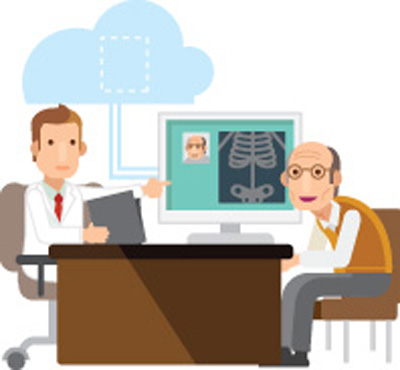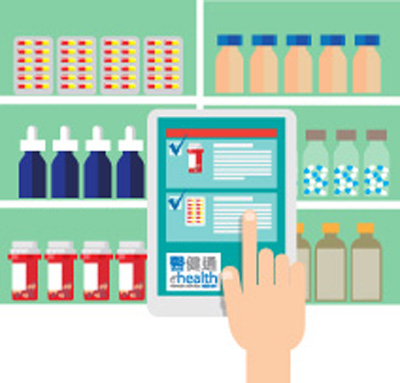 |
Radiographers and pharmacists of the Hospital Authority, the Department of Health and private hospitals are among the six healthcare professional (HCProf) groups given access to the Electronic Health Record Sharing System (eHRSS) last year. eHealth News has invited their representatives to share their views on the system. |
|
|
Dr Cheng Pui Wai,
Radiologist-in-charge,
Scanning Department,
St. Teresa’s Hospital
(STH)
|
|
|
| Speaking on behalf of the radiographers of the hospital, Dr Cheng reflected that his colleagues welcome the implementation of eHRSS and feedback has been positive. |
|
|
|
| Citing an example in diagnostic radiology services, Dr Cheng said patients’ health information is important to radiographers in their work. |
| |
| “Some patients, such as seniors or those with diabetes, may have adverse reaction to contrast agents which are often required for computed tomography scans. Radiographers need to know patients’ drug allergy records and their renal functions in order to determine whether it is suitable to give them contrast injections or how much should be administered. This is for their safety,” he explained. |
| |
| “Also, if we know that patients have already taken certain medical examinations in public hospitals, we can avoid repeating the same items. Instead, we can have better use of time and resources to plan for other investigations. This would not have been easily done without eHRSS.” |
| |
| Learning that eHRSS access will soon be extended to community-based radiographers, Dr Cheng considered that HCProfs, whether from the public or private sectors, should be able to access patients’ information as long as they are properly trained. |
| |
| “Wherever a patient is, when he/ she needs healthcare services, any HCProf would need the patient’s health information to deliver proper care,” he said. |
| |
| Dr Cheng further stressed the importance of balancing personal privacy and HCProfs’ need to know in order to provide healthcare services. “The security measures and the role-based access control mechanism (RBAC) of eHRSS have been working well to protect data privacy,” he commented. |
| |
 |
| For patients' safety, radiographers need to know their drug allergy records etc. in order to determine whether it is suitable to give them contrast injections or how much should be administered |
|
| |
|
Mr Eric Wong,
Chief Pharmacist,
Pharmacy Department,
STH
|
|
|
Mr Wong said eHRSS has been well received by pharmacists, adding that it can improve drug safety by providing a platform for sharing standardised drug data and optimising the medication process.
|
|
|
|
| Using Clinical Management System adaptation modules developed for eHRSS, Mr Wong said pharmacists are able to input structured data in accordance with the standards applied in the system. |
| |
| “For example, we have adopted the Structured Alert Adaptation Module (SAAM) developed for eHRSS to capture patients’ allergy records. Data input using SAAM is standardised and well structured, with the allergen list coming from the Hong Kong Medication Terminology Table,” he said. |
| |
| Mr Wong added that from drug allergy and adverse reaction, to prescribing, dispensing and administration of drugs, eHRSS enables documentation of structured data. “eHRSS can play a role in allergy and drug checking that supports medication decision process,” he emphasised. |
| |
| Commenting on the extension of eHRSS access to community-based pharmacists, Mr Wong said that it can help reduce the workload of the public healthcare sector, while maximising use of resources at the community. |
| |
| “Very often patients are consulting different doctors and may receive similar medications for the same illness. The information sharing of eHRSS platform can facilitate in addressing the problem of polypharmacy, and community-based pharmacists can also help in the process of medication reconciliation to avoid duplication of medication or drug interaction,” said Mr Wong. |
| |
| “Ultimately it can strengthen a patient-oriented culture, and is helpful to the profession’s development.” |
| |
| On the implementation of RBAC, Mr Wong agreed that the mechanism has been working well in STH. “We educate our frontline colleagues on eHRSS data security and privacy and make them understand that accesses will be logged and audited,” he said. |
| |
|
Ms Agnes Lau,
Clinical Pharmacist,
Queen Mary Hospital
|
|
|
| As a clinical pharmacist working with doctors and nurses in hospital inpatient wards, Ms Lau has full eHRSS access and believes the system is a bridge between primary and secondary healthcare. |
|
|
|
| “In our day-to-day work, we need to know the medication and vaccination histories of patients, what medications they are taking, including not only those prescribed by primary care doctors, but also Chinese medicines or even dietary supplements,” she said. |
| |
| “Sometimes vaccination, health supplements and over-the-counter drugs may cause allergies or adverse reactions in patients. Patient records in this respect are absolutely useful to HCProfs. If we can get the information from eHRSS, we can have a more comprehensive picture on the prescription and compliance of medication of the patients, which in turn helps improve healthcare quality and drug safety,” added Ms Lau. |
| |
| Ms Lau welcomed the move to enable eHRSS access for her counterparts in the community, saying it can meet the needs of society, as well as enhance the professionalism of the pharmacy industry. |
| |
| “There is increasingly more public-private partnership in medication dispensary. Patients will visit local pharmacy shops for self-financed drugs prescribed by public hospitals. At the same time, some non-governmental organisations also run community pharmacies. For some self-financed drugs such as anti-coagulant and targeted drug for cancer treatment, their usage has to be closely monitored. Drug checking by community-based pharmacists therefore helps enhance patient safety.” |
| |
| “Our hospital has once received a call from a pharmacist working at a major chain pharmacy shop to verify a change in the prescription of a diabetic patient who is a long-time customer of the shop. It would be of much help if such information is shared to them through eHRSS,” she said. |
| |
| When talking about how to encourage more of her counterparts to participate in eHRSS, Ms Lau suggested the Government could promulgate more about the benefits of eHRSS on both patient safety and how HCProfs would be better supported by the system in delivering healthcare services. She also suggested that a certification mechanism for eHRSS participating community pharmacies might be explored, so that the general public will have more confidence in getting prescription there, which, in a way, could drive more participation of HCProfs in eHRSS. |
| |
 |
| Drug checking with the use of eHRSS information by community-based pharmacists helps enhance patient safety |
|
| |

|



